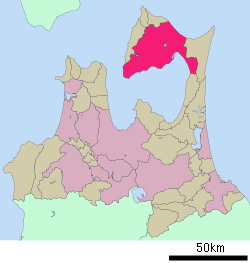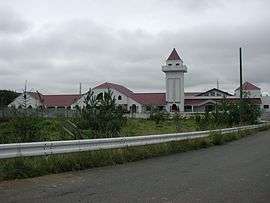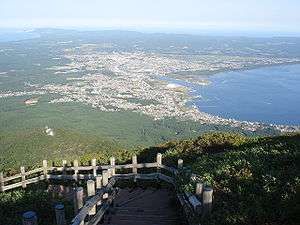Mutsu, Aomori
| Mutsu むつ市 | |||
|---|---|---|---|
| City | |||
|
Mutsu City from Kamafuse-yama | |||
| |||
 Location of Mutsu in Aomori Prefecture | |||
 Mutsu
| |||
| Coordinates: 41°17′34.2″N 141°11′1″E / 41.292833°N 141.18361°ECoordinates: 41°17′34.2″N 141°11′1″E / 41.292833°N 141.18361°E | |||
| Country | Japan | ||
| Region | Tōhoku | ||
| Prefecture | Aomori Prefecture | ||
| Government | |||
| • - Mayor | Jun'ichirō Miyashitai | ||
| Area | |||
| • Total | 864.16 km2 (333.65 sq mi) | ||
| Population (February 2016) | |||
| • Total | 58,286 | ||
| • Density | 67.4/km2 (175/sq mi) | ||
| Time zone | Japan Standard Time (UTC+9) | ||
| City symbols | |||
| -Tree | Thujopsis | ||
| -Flower | Rosa rugosa | ||
| -Bird | Whooper swan | ||
| Phone number | 0175-22-1111 | ||
| Address | 1-1-1, Kanaya, Mutsu-shi, Aomori-ken035-8686 | ||
| Website | Official website | ||

Mutsu (むつ市 Mutsu-shi) is a city located in northeastern Aomori Prefecture in the northern Tōhoku region of Japan. As of 1 February 2016, the city had an estimated population of 58,286 and a population density of 67.4 persons per km². Its total area was 29.43 square kilometres (11.36 sq mi). The total area was 864.16 square kilometres (333.65 sq mi), making it the largest municipality in Aomori Prefecture in terms of area.
Geography
Mutsu occupies most of Shimokita Peninsula and is bordered by Mutsu Bay to the south and the Tsugaru Strait to the north, and is the northernmost city on Honshū. Much of the city is within the limits of the Shimokita Hanto Quasi-National Park. The volcanic Osorezan Mountain Range extends across the northern portion of the city, and includes a number of caldera lakes.
Neighbouring municipalities
- Aomori Prefecture
Climate
Mutsu has a cold maritime climate (Köppen climate classification Cfb) bordering on a humid continental climate (Köppen Dfb) characterized by mild summers and cold winters with heavy snowfall.
| Climate data for Mutsu, Aomori | |||||||||||||
|---|---|---|---|---|---|---|---|---|---|---|---|---|---|
| Month | Jan | Feb | Mar | Apr | May | Jun | Jul | Aug | Sep | Oct | Nov | Dec | Year |
| Average high °C (°F) | 1.1 (34) |
1.3 (34.3) |
4.8 (40.6) |
12.0 (53.6) |
17.5 (63.5) |
20.0 (68) |
23.5 (74.3) |
25.6 (78.1) |
22.1 (71.8) |
16.9 (62.4) |
10.3 (50.5) |
4.2 (39.6) |
13.28 (55.89) |
| Daily mean °C (°F) | −1.9 (28.6) |
−2.0 (28.4) |
1.1 (34) |
7.0 (44.6) |
12.1 (53.8) |
15.6 (60.1) |
19.5 (67.1) |
21.7 (71.1) |
17.6 (63.7) |
11.8 (53.2) |
6.2 (43.2) |
1.0 (33.8) |
9.14 (48.47) |
| Average low °C (°F) | −5.7 (21.7) |
−6.6 (20.1) |
−3.1 (26.4) |
2.3 (36.1) |
7.1 (44.8) |
11.8 (53.2) |
16.2 (61.2) |
18.3 (64.9) |
13.1 (55.6) |
6.3 (43.3) |
1.6 (34.9) |
−2.7 (27.1) |
4.88 (40.78) |
| Average precipitation mm (inches) | 104.5 (4.114) |
79.0 (3.11) |
77.1 (3.035) |
90.1 (3.547) |
81.0 (3.189) |
105.7 (4.161) |
124.8 (4.913) |
144.1 (5.673) |
166.7 (6.563) |
109.2 (4.299) |
117.5 (4.626) |
97.4 (3.835) |
1,297.1 (51.065) |
| Average snowfall cm (inches) | 140 (55.1) |
119 (46.9) |
52 (20.5) |
4 (1.6) |
0 (0) |
0 (0) |
0 (0) |
0 (0) |
0 (0) |
0 (0) |
14 (5.5) |
86 (33.9) |
415 (163.5) |
| Average relative humidity (%) | 75 | 75 | 72 | 71 | 74 | 83 | 86 | 85 | 81 | 74 | 72 | 75 | 76.9 |
| Mean monthly sunshine hours | 78.9 | 95.8 | 157.8 | 197.9 | 219.3 | 175.4 | 158.2 | 155.3 | 152.2 | 165.7 | 107.8 | 73.6 | 1,737.9 |
| Source: NOAA (1961-1990) [1] | |||||||||||||
History
Mutsu was founded as September 1, 1959 through the merger of the former towns of Ōminato and Tanabu. Tanabu had been the location of a daikansho under the Morioka Domain in the Edo period, and was a resettlement and colonization zone for dispossessed ex-samurai of the defeated Aizu Domain after the Boshin War. Ōminato was a port town, and home to the Ōminato Guard District, a major base for the Imperial Japanese Navy until the end of World War II. The base facilities were used by the United States Navy during the occupation of Japan, and (on a reduced scale) by the Japan Maritime Self Defence Force to date.
The new city was originally called Ōminato-Tanabu (coupling of the names of two antecedent towns); its name was changed to Mutsu in 1960. At the time, it was the only city with a hiragana name (むつ), which was adopted to avoid confusion with the original kanji word Mutsu (陸奥) which indicates the old province that covered most of the modern Tōhoku region.
On March 14, 2005, the towns of Kawauchi and Ōhata, and the village of Wakinosawa (all from Shimokita District) were merged into Mutsu.
Economy
The economy of Mutsu is heavily dependent on agriculture, forestry and fishing, especially scallop aquaculture in Mutsu Bay. The city is also the location for various facilities of the Japan Atomic Energy Agency, and was the home port for the nuclear powered research vessel Mutsu, until its decommissioning in 1997.
Education
Mutsu has 13 elementary schools, nine middle schools and four high schools.
High schools
- Tanabu High School
- Ōminato High School
- Mutsu Technical High School
- Ōminato High School - Kawauchi Branch
Transportation
Railway
Highway
Noted people from Mutsu
- Yuya Asahina – manga artist
- Yuzo Kawashima – movie director
- Ryu Fujisaki – manga artist
- Fumie Hosokawa – actress and gravure model
- Kenichi Matsuyama – actor
International relations
References
- ↑ "Mutsu Climate Normals 1961-1990". National Oceanic and Atmospheric Administration. Retrieved December 29, 2012.
- ↑ "US-Japan Sister Cities by State". Asia Matters for America. Honolulu, HI: East-West Center. Retrieved 20 November 2015.
External links
![]() Media related to Mutsu, Aomori at Wikimedia Commons
Media related to Mutsu, Aomori at Wikimedia Commons
- Official website (Japanese)

